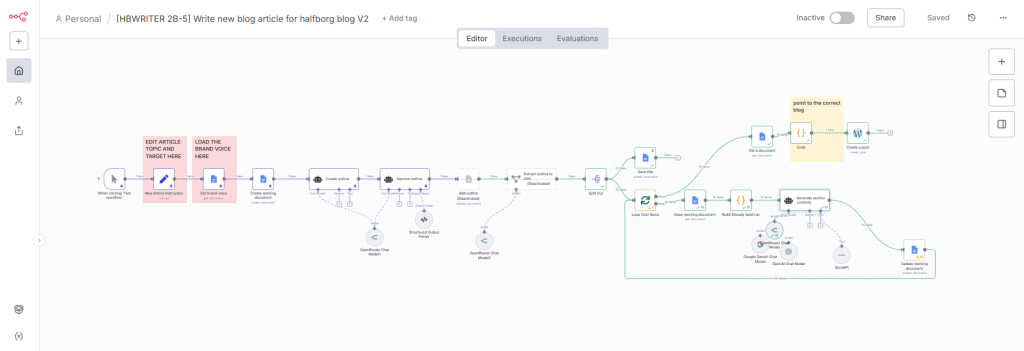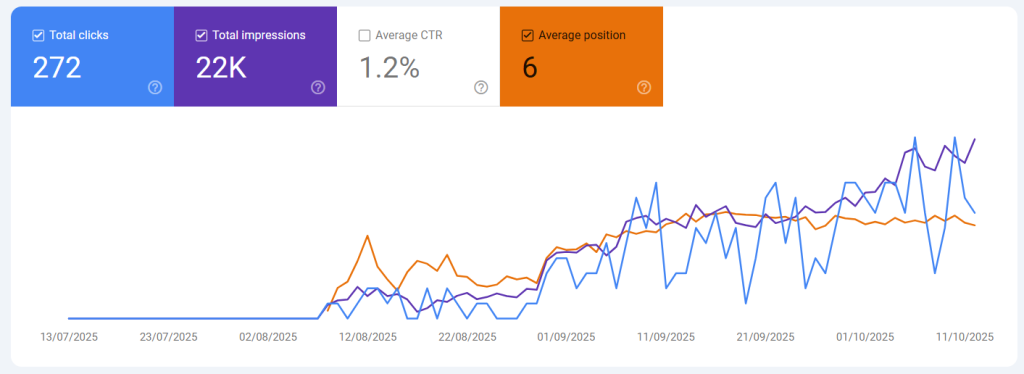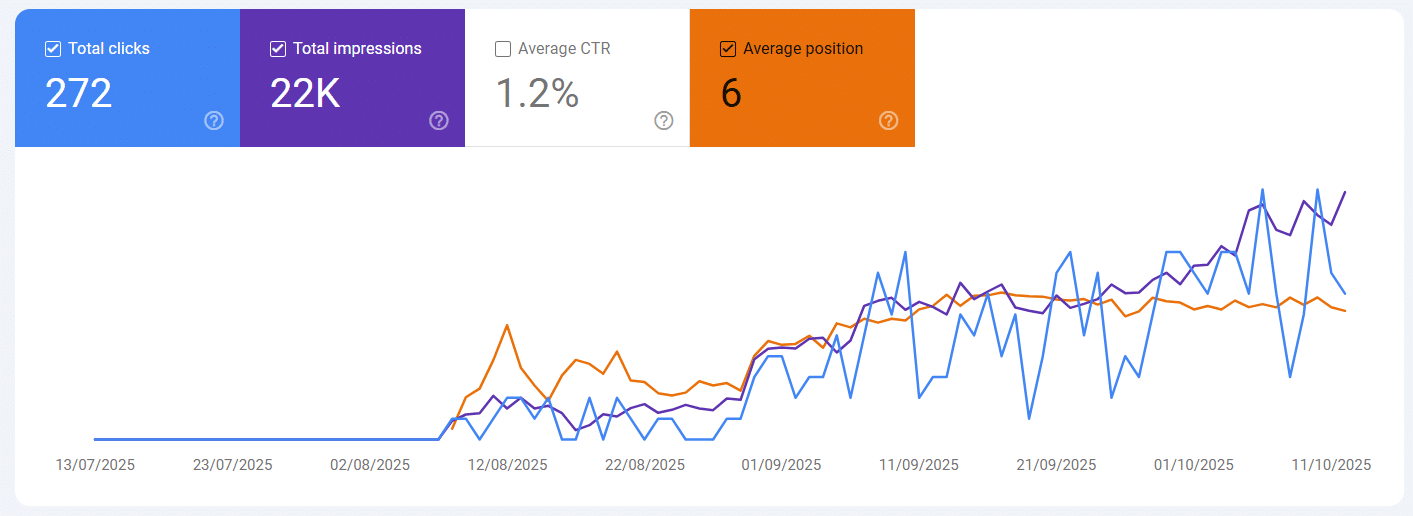I built an n8n workflow that generates a near‑publishable first draft articles in three minutes, stays on voice, and respects your brand guidelines.
Over the years, Google’s core updates have really tightened the screws on low‑quality content. One major one happened in March 2024; a clear crackdown on AI-generated content that did not add value.
But, Google still rewards publishers that post on a regular schedule. So your content teams still need to be quick, but every single blog post must be helpful and accurate. You also want it to reflect your brand’s unique voice.
So this workflow helps you find that sweet spot. It balances automation with human judgement, so you can publish confidently without sacrificing quality.
The Workflow At A Glance

This workflow is all about multi-stage prompting. Many marketers put their topic into chatgpt and get one result. The results are decent, but it may not have enough depth to rank.
Think of it like a meticulous chef preparing a dish. You don’t just dump all the ingredients in at once, right?
So, in this workflow, we split the content production into steps.
- First, we plan the article outline.
- Then, we critique the plan to make sure it’s solid.
- After that, we write each section one by one.
- We then assemble everything, and do final checks.
And that’s where n8n comes in. It orchestrates all these steps, making sure the process is repeatable and easy to audit.
Feeding Your Topic
Because this workflow is more complex, you need to feed it more detailed inputs.
First, you should provide your topic or article headline.
Then, who you’re writing for (your audience), and what you want to achieve (your objective).
For SEO focus, you need to also add your keywords.
Finally, you should include your brand’s editorial guidelines. This includes details on the tone of voice, structure, overview of your business, and any other rules to follow. This way, everything is on point from the start.
Output
At the end of the workflow, you get a really clean first draft that is already saved as a draft in your target WordPress blog.
It comes with all the right headings, in-depth content, suggested external links, and even ideas for diagrams and images.
Why This Workflow Works Better Than a “One-Shot” Prompt
You have probably tried asking chatgpt to “write something in the style of…”. Personally, I have generated articles in the voice of Gandalf, or Jeremy Clarkson. But what if you need a specific style that is unique to your brand? When different writers or even different AI tools are used, your content can start sounding inconsistent.
So, how does this workflow help? For a start, stronger outlines mean your articles cover topics more deeply. This also sends better E-E-A-T signals to Google.
It shows that you are an expert, that you have experience, that you are authoritative, and that you are trustworthy.
Plus, you get a consistent tone built into every single step. You don’t have to worry about checking these things only at the end. It’s all there from the beginning.
This workflow helps you achieve faster throughput without sacrificing trust. You can produce more content, and your readers will still trust what you say.
A Real-World Example
Here is a demonstration that I did recently for my wife’s skincare website:
Step 1: Start in Google Search Console
To kick off this journey to generate brand-safe SEO articles, we start in Google Search Console (GSC).
If you already have a blog, you can hook it up to GSC to see what search terms are bringing traffic to your site. You should filter your queries to find ones with good impressions but an average position between 8 and 20. These are your quick wins. They’re already ranking, so a little push can get them to the first page.
In my example, I identified the term “arm sleeves for eczema” as a potential topic.
Step 2: Configure Inputs In n8n Workflow
Here are the inputs that I used:
Topic: "What You Need To Know About Eczema Sleeves"
Notes: "Why eczema commonly appears on arms and legs, how eczema sleeves help, what to look for when buying eczema sleeves"
Target: people experiencing eczema on arms and legs
Objective: explain the benefits of eczema sleeves and where to buy
Keywords: eczema sleevesI also loaded up the brand voice rules for this particular blog (I already generated one for this blog earlier, using a separate workflow – but that’s for another post).
Step 3: Multi‑Stage AI Writing
Then we get into the multi-stage AI writing process.
First up, we have Stage 1: the outline prompt. This is where we lay the groundwork for a solid article.
Your prompt should tell the AI to cover the primary intent of the article, all the subtopics, frequently asked questions (FAQs), and any comparisons that are important. The idea is to get a comprehensive view of the entire topic.
It’s also crucial to force the AI to use proper H2 and H3 structures. This makes the article well-organised and easy to read.
Stage 2 is to improve and tighten. We ask the AI to critique the outline itself. It looks for any gaps, checks for redundancy, and makes sure it fits the search intent perfectly. This step makes the outline much stronger.
In Stage 3, we ask the AI to write the article section by section. By requesting one section at a time, we really reduce generic filler. The AI focuses on a smaller piece of content, which leads to higher quality and more relevant writing.
Stage 4 will combine all the written sections into a single document, and upload it as a draft to WordPress. Since it is typically written in markdown language, I will do a conversion here, so that all the headings, paragraphs, bullet points will carry over into the blog post neatly.
Stage 5 is when i do a manual review and edit. It’s also a chance for me to check for any claims that need citation, as well as images that need to be added.
Results And Impact
So, what’s the big payoff from using this multi-stage AI workflow? It’s not just about being fancy; it delivers real results and impacts your content strategy.
This workflow really makes a difference to time savings. Imagine, just three minutes of automation, and then maybe 30 minutes of your own editing. That’s all it takes to get a solid, brand-safe article ready.
But it’s not just about speed; the quality goes up too. Because of the staged writing process and those critical gap critiques, your articles cover topics in much more depth.
Your brand’s voice also stays consistent across all your posts. No more drifting. Every article will sound like it came from the same trusted source.

Real example: I used this workflow to generate an article about electrical hazards at home. Within 3 months, it went to position 6, and has since received 22000 impressions and 272 clicks.
So, do you still need a writer?
Yes, you definitely still need a human writer, or at least an editor with a sharp eye and good subject knowledge. The human touch still matters. The AI helps with the heavy lifting, but the nuance, creativity, and personal insight will come from you.
Want to implement this for your blog?
I can set you up with the right system to get your content factory up and running:
- Analysing your old articles to develop an editorial and brand guidance document
- Implementing this automation for your team to use
- Creating a self-updating repository of your articles, so that any new articles you generate will have internal linking built in
Contact me below and let’s discuss!



Leave a Reply